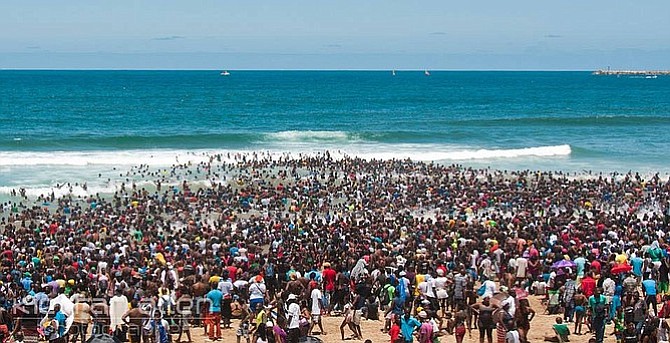 Facebook
Facebook
 X
X
 Instagram
Instagram
 TikTok
TikTok
 Youtube
Youtube

It was New Year’s Day, and the party in Chintsa, on South Africa’s Eastern Cape, had been long and wild. The hangover was severe, and the need to leave immediate.
You see, included on the long and varied list of perverse indignities the apartheid regime saw fit to inflict on its black citizens was the appalling and puerile notion that even beaches should be segregated. The best beaches, of course, were for whites only.
The fall of apartheid and the absence of their depraved laws ignited a volatile tradition.
On the first day of every year, blacks by their thousands move seaward from all over the country to reclaim their beaches once more. By the time they reach the ocean, they are far too charged up on moonshine and decades of resentment for any authority to control, and the outfall is ugly. Tales of these epic gatherings are many and brutal — a savage catalogue of indecency, injury, and lost children. In an effort to reduce crowding and contain chaos, all roads and public transport are shut down.
There was no way out of town, and great hordes of understandably vengeful natives were swiftly bearing down. The best way to outlast the day was to find the highway and hitchhike west.
The road out of Chintsa is winding and steep, and I was headed upstream against a great river of mayhem. The rabble was flowing in, and the mood for now was boisterous but jovial. Many shouldered ghetto blasters cranking Kwaito at maximum volume. There was much roughhousing, and here and there the initial sparks of escalating violence. The ground was an open sea of smashed bottles and bleeding feet.
It was a bad situation that was getting worse. Many blacks themselves don’t make it out alive, and if you are white, you are expected to hide.
If you’re a white policeman, however, you can’t.
“You’d better get the hell out of here bru!” he shouted.
“I know!” I shouted. “But how!?”
“Come with me,” he said.
The rusty, seatless cage in the back of a 1967 South African paddy wagon isn’t as comfortable as it sounds, even if you have it to yourself on a private evacuation to Kwelera, twenty minutes inland, where things, it was rumored, were “survivable.”
Forty minutes went by, and I thought I might have been forgotten. But two hours later, I was absolutely sure.
The officer and his partner were visible through a window, sipping coffee, oblivious while I banged on the bars like a trapped monkey.
Eventually they pulled into a restaurant parking lot, killed the engine, and finally heard the desperate commotion at the back of the van.
With tilted caps and ardent apologies, they unlocked the cage, and I was free.
“So sorry bru!” he said.
“It’s ok,” I said. “Thanks for getting me out of there. Way, way, out of there.”


It was New Year’s Day, and the party in Chintsa, on South Africa’s Eastern Cape, had been long and wild. The hangover was severe, and the need to leave immediate.
You see, included on the long and varied list of perverse indignities the apartheid regime saw fit to inflict on its black citizens was the appalling and puerile notion that even beaches should be segregated. The best beaches, of course, were for whites only.
The fall of apartheid and the absence of their depraved laws ignited a volatile tradition.
On the first day of every year, blacks by their thousands move seaward from all over the country to reclaim their beaches once more. By the time they reach the ocean, they are far too charged up on moonshine and decades of resentment for any authority to control, and the outfall is ugly. Tales of these epic gatherings are many and brutal — a savage catalogue of indecency, injury, and lost children. In an effort to reduce crowding and contain chaos, all roads and public transport are shut down.
There was no way out of town, and great hordes of understandably vengeful natives were swiftly bearing down. The best way to outlast the day was to find the highway and hitchhike west.
The road out of Chintsa is winding and steep, and I was headed upstream against a great river of mayhem. The rabble was flowing in, and the mood for now was boisterous but jovial. Many shouldered ghetto blasters cranking Kwaito at maximum volume. There was much roughhousing, and here and there the initial sparks of escalating violence. The ground was an open sea of smashed bottles and bleeding feet.
It was a bad situation that was getting worse. Many blacks themselves don’t make it out alive, and if you are white, you are expected to hide.
If you’re a white policeman, however, you can’t.
“You’d better get the hell out of here bru!” he shouted.
“I know!” I shouted. “But how!?”
“Come with me,” he said.
The rusty, seatless cage in the back of a 1967 South African paddy wagon isn’t as comfortable as it sounds, even if you have it to yourself on a private evacuation to Kwelera, twenty minutes inland, where things, it was rumored, were “survivable.”
Forty minutes went by, and I thought I might have been forgotten. But two hours later, I was absolutely sure.
The officer and his partner were visible through a window, sipping coffee, oblivious while I banged on the bars like a trapped monkey.
Eventually they pulled into a restaurant parking lot, killed the engine, and finally heard the desperate commotion at the back of the van.
With tilted caps and ardent apologies, they unlocked the cage, and I was free.
“So sorry bru!” he said.
“It’s ok,” I said. “Thanks for getting me out of there. Way, way, out of there.”
Comments